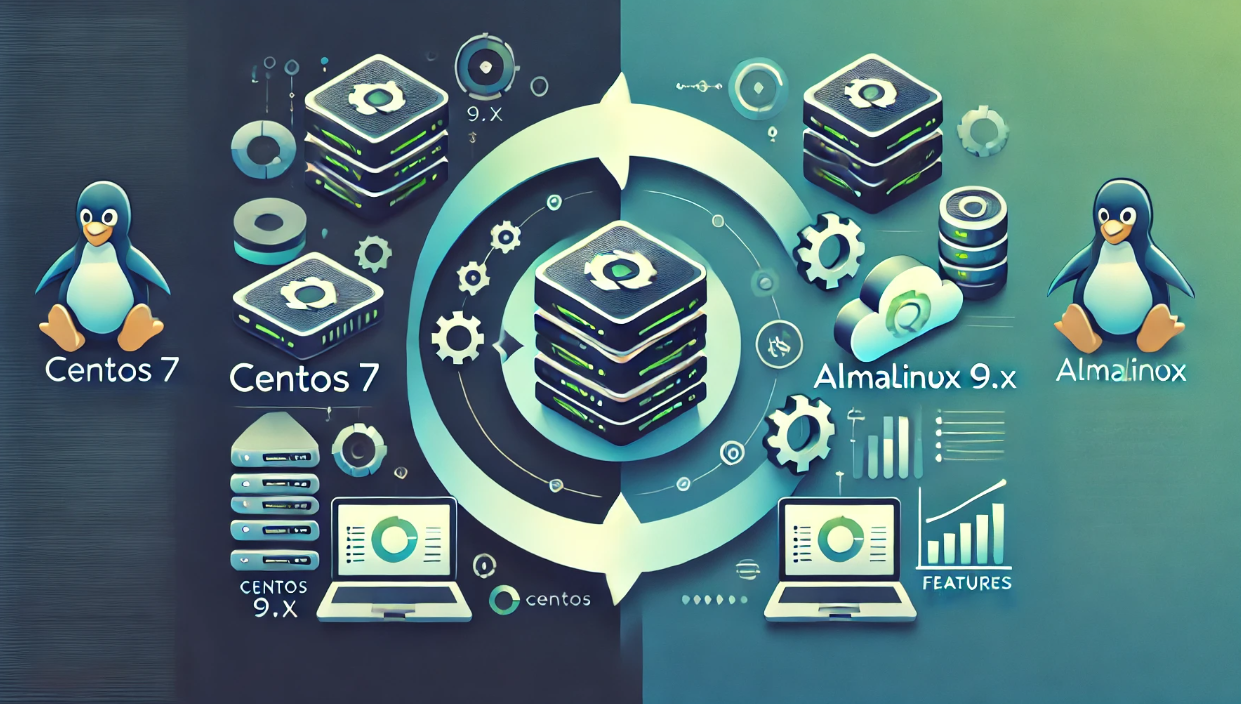Differences Between CentOS 7 and AlmaLinux 9.x: What to Expect After Switching
CentOS has long been a trusted choice for enterprise and server environments. However, with the shift in CentOS development to CentOS Stream, many users have migrated to alternatives like AlmaLinux. AlmaLinux 9.x, developed as a direct replacement for CentOS, offers a stable and secure platform for businesses. This blog explores the key differences between CentOS 7 and AlmaLinux 9.x and highlights the benefits clients can enjoy after making the switch.
Key Differences Between CentOS 7 and AlmaLinux 9.x
1. Release Model
-
CentOS 7:
-
Follows a traditional release model, with updates and support for a specific lifecycle.
-
End-of-Life (EOL) for CentOS 7 is June 30, 2024.
-
-
AlmaLinux 9.x:
-
Follows Red Hat Enterprise Linux (RHEL) closely, offering binary compatibility.
-
Supported with long-term updates and security patches.
-
2. Kernel Version
-
CentOS 7:
-
Ships with an older 3.10 kernel, which limits hardware compatibility and performance for modern systems.
-
-
AlmaLinux 9.x:
-
Uses the newer 5.14 kernel, offering improved hardware support, enhanced performance, and better power efficiency.
-
3. Default Software Packages
-
CentOS 7:
-
Features older versions of software packages, including outdated Python, Apache, and PHP versions.
-
-
AlmaLinux 9.x:
-
Provides updated software stacks, including:
-
Python 3.9.
-
PHP 8.0.
-
Apache 2.4 with newer features and performance enhancements.
-
-
4. Security Enhancements
-
CentOS 7:
-
Lacks support for many modern security protocols and frameworks.
-
-
AlmaLinux 9.x:
-
Includes significant security improvements:
-
SELinux enhancements for better policy management.
-
OpenSSL 3.0 for improved cryptographic performance and security.
-
Updated firewalld for managing complex firewall rules.
-
-
5. Container Support
-
CentOS 7:
-
Basic support for container technologies, but limited to older versions of Docker.
-
-
AlmaLinux 9.x:
-
Enhanced support for containerization with:
-
Podman and Buildah as Docker alternatives.
-
Seamless integration with Kubernetes.
-
-
6. Performance and Efficiency
-
CentOS 7:
-
Designed for older systems, resulting in suboptimal performance on modern hardware.
-
-
AlmaLinux 9.x:
-
Optimized for modern CPUs and storage devices, improving performance and scalability.
-
Benefits of Switching to AlmaLinux 9.x
1. Long-Term Support
Clients migrating to AlmaLinux 9.x gain access to a robust support lifecycle, with updates and security patches for at least 10 years.
2. Improved Security
-
Enhanced security features reduce vulnerabilities and protect critical infrastructure.
-
Faster updates ensure immediate fixes for discovered vulnerabilities.
3. Access to Modern Software
-
AlmaLinux provides updated versions of essential software, supporting modern development and hosting needs.
-
Compatible with DevOps tools and workflows, including CI/CD pipelines.
4. Seamless Migration Tools
-
AlmaLinux offers a free migration script to help users transition from CentOS 7 without significant downtime or data loss.
5. Community-Driven Development
-
Supported by a global community and governed by a non-profit foundation, ensuring transparency and open development.
6. Containerization Support
-
Native support for Podman, Kubernetes, and other container technologies makes AlmaLinux ideal for deploying cloud-native applications.
How to Migrate from CentOS 7 to AlmaLinux 9.x
Step 1: Backup Your Data
Before migration, ensure all critical data and configurations are backed up.
Step 2: Download the AlmaLinux Migration Tool
Install the official migration script provided by AlmaLinux:
curl -O https://raw.githubusercontent.com/AlmaLinux/almalinux-deploy/master/almalinux-deploy.sh
Step 3: Run the Migration Script
Execute the migration script to start the process:
bash almalinux-deploy.sh
Step 4: Verify Migration
After the script completes, verify the migration:
cat /etc/redhat-release
You should see “AlmaLinux 9.x” as the output.
Step 5: Reboot and Test
Reboot the server and test all services to ensure they function as expected.
Conclusion
Switching from CentOS 7 to AlmaLinux 9.x is a forward-looking decision for businesses and developers. AlmaLinux offers enhanced security, modern software support, and robust performance tailored for current and future demands. With its seamless migration process and long-term support, AlmaLinux is an excellent choice for those seeking stability and reliability in their Linux environments.

